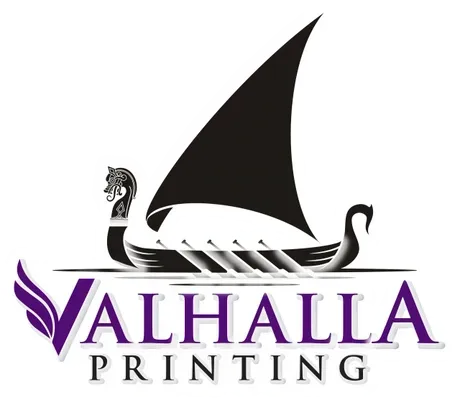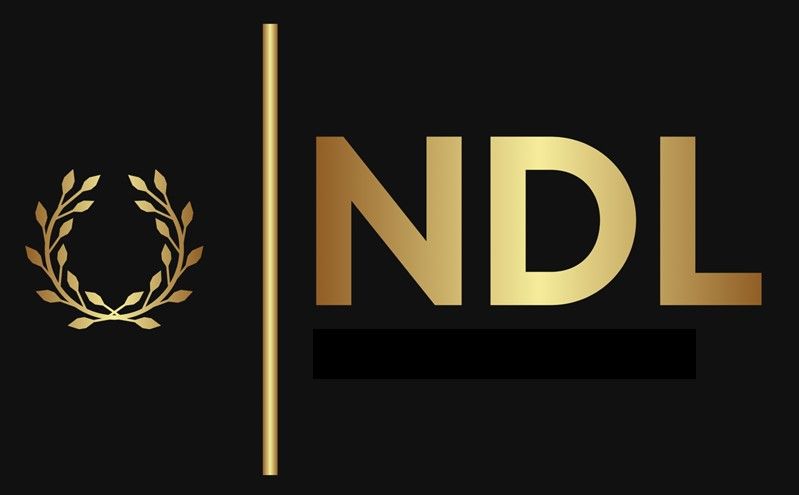Top 10 Reasons Printed Materials Should Be the Yin to Your Digital Marketing Yang
Our friend Lars at Vahalla Printing wrote this great blog about how digital and print media work together.

Top 10 Reasons Printed Materials Should Be the Yin to Your Digital Marketing Yang
Written by Lars Björklund Valhalla Printing
In today’s fast-moving digital world, marketing strategies have become increasingly focused on online platforms. Social media, email newsletters, SEO, and pay-per-click ads dominate the landscape. But with so much digital noise, it's easy to forget the enduring power of a well-designed printed piece. Print isn't dead, it's the perfect partner to your digital marketing strategy.
Print offers something that digital can’t: tangibility, permanence, and physical engagement. While digital marketing excels at speed and scale, printed materials slow the pace, deepen engagement, and create an emotional connection that screens often fail to replicate. This balance makes print and digital such powerful allies.
Here are the top 10 reasons why printed materials should be the yin to your digital marketing yang:
1. Tangibility Creates Trust
Printed materials have a physical presence unlike digital content, which lives in an ephemeral, swipe able world. You can hold them, feel their texture, and place them on a desk or bulletin board. This physicality builds credibility. Consumers inherently trust printed materials more because of the perceived effort and investment behind them. A glossy brochure, business card, or catalog suggests professionalism and reliability in a way a quick email never could.
When people interact with something tangible, it connects with them differently. A printed thank-you note, or a personalized flyer has literal and emotional weight. It’s not fleeting or easily deleted. It feels intentional. This is a significant advantage when building or maintaining trust in a marketplace where consumers are constantly wary of scams and noise.
2. Print Cuts Through the Digital Clutter
Online users are bombarded with ads whenever they scroll, click, or stream. This digital saturation can lead to banner blindness, where audiences stop noticing online ads. Print materials, on the other hand, stand out. A beautifully designed postcard in the mailbox or a vibrant flyer on a counter draws attention by default, precisely because it’s not on a screen.
Imagine you walk into a coffee shop and see a well-designed rack card promoting a local business. Your eyes catch the colors, the layout, and the concise, compelling message. There’s no pop-up, no forced autoplay video—just messaging that respects your time and attention. That’s the strength of print. And it isn’t just about visual interruption—it’s about thoughtful placement in real-world settings.
3. Higher Engagement and Recall
Numerous studies have shown that people are more likely to keep information they read in print than in digital form. One Canada Post and True Impact study found that printed marketing requires 21% less cognitive effort to process and leads to a higher brand recall. When your message sticks, your brand does too.
There’s science behind this. Holding printed material stimulates unusual parts of the brain compared to consuming content on a screen. Physical interaction increases neural engagement, helping people absorb and remember more. This is critical in marketing, where top-of-mind awareness can be the difference between a sale and a missed opportunity.
Marketers looking to maximize memory and message resonance should incorporate print pieces into any campaign where customer loyalty, education, or storytelling is a key goal.
4. Shelf Life: Longevity Beyond the Click
An email might be deleted within seconds. A social media ad might get scrolled past in less than a second. But printed materials linger. A brochure might stay on a coffee table for weeks. A poster on a wall becomes a daily visual reminder. This longer lifespan boosts your chances of being seen, remembered, and acted upon.
Even better, these materials often continue working for you without additional spending. A digital ad runs only as long as you're paying for it. A printed brochure might still generate leads months after it was first distributed. And unlike an ad that gets lost in the shuffle, your physical material may get passed around, reaching more people organically.
This is especially true in professional environments where printed items like notepads, folders, and presentation materials live long lives in meeting rooms and offices.
5. Personalized Print = Personal Connection
Just like digital ads can be personalized, so can print. Companies can use variable data printing to tailor postcards, letters, and brochures with customer names, custom offers, and even relevant images. A direct mail piece that greets someone by name and acknowledges their preferences can create an emotional connection that digital alone can't replicate.
Let’s say you’re a local fitness center. Imagine sending a mailer to a customer that says, “Hey Sarah, ready to hit your summer fitness goals?” That trim level of personalization, combined with a tangible reminder, often earns better response rates than a cold email blast ever could. When someone receives something made just for them, it naturally deepens engagement.
Personalized packaging and event invitations also make excellent use of print’s unique connection ability. Tangible print pieces, whether a handwritten note or a name-engraved flyer, feel more thoughtful and impactful.
6. Print Enhances Brand Aesthetics
There is a tactile luxury to well-designed print materials that convey brand quality. Think about the weight of a thick business card, the embossing on a folder, or the smooth finish of a matte postcard. These aren’t just functional choices; they communicate your brand’s mindfulness and aesthetic values. In an age where brand perception is everything, premium print materials go a long way.
Superior design isn’t just about visuals—it’s about experience. The texture, the layout, the paper types all play a role in how people perceive your brand. A cheap-feeling flyer might make your product feel cheap. But an elegantly designed, high-quality printed piece says, “We care about excellence.”
Add foil stamping, spot UV gloss, or unique die cuts, and your brand will stand out as premium. These sensory-rich details aren't just pretty—they make your brand unforgettable.
7. Print Drives Online Engagement
Far from being isolated, print and digital work best when integrated. A postcard with QR code, a magazine ad with a custom URL, or a flyer promoting your social media handle can bridge the gap. Print can direct customers to your website, encourage app downloads, or promote an online event. This cross-pollination boosts engagement across both platforms.
Research shows that combining digital with print improves response rates by over 20%. For example, you might drive a customer to your website via Instagram but close the sale with a catalog they kept on their kitchen counter. The trick is making the transition between platforms as easy and natural as possible.
Savvy marketers use print as a powerful offline lead magnet. Whether it’s a discount code, event reminder, or promotional item, print can entice people to take digital action—and vice versa.
8. Ideal for Local and Niche Targeting
While digital ads can be geo-targeted, print thrives in hyperlocal and niche markets. A rack card in a local coffee shop, a door hanger campaign, or brochures at a trade show can target audiences in the exact physical spaces they frequent. For many businesses, mainly local or service-based, this tangible proximity is more effective than online impressions.
For example, a landscaping company might drop beautifully branded door hangers in a specific neighborhood, or a yoga studio might leave flyers in wellness clinics and organic cafes. These materials reach people where they live, work, and spend time. They’re not just marketing pieces, they become part of the environment.
In niche markets like luxury real estate, custom car detailing, or boutique fashion, printed materials offer a tactile preview of the elevated experience customers can expect.
9. Less Competition, More Visibility
While every business is flooding into boxes and social feeds, far fewer use print consistently. This gives your business a chance to stand out. A printed piece in the mailbox is far more likely to be noticed than another email in a crowded inbox. Print gives you space to shine where others aren’t looking.
Because of print's perceived cost and complexity, many companies have shifted entirely to digital. That means print is now a less crowded space. You can dominate the attention of your local audience by simply showing up in their physical world. If everyone zigs to digital, you can zag to print and grab the spotlight.
This also applies to trade shows, local fairs, and in-person networking events, where showing up with high-end, thoughtfully printed collateral sets you apart from the sea of generic flyers.
10. Omnichannel Marketing Works
Studies consistently show that marketing campaigns that use print and digital together outperform those that use only one. According to a Canada Post study, campaigns that integrated direct mail and digital had 39% more attention, 10% more brand recall, and 5% greater engagement. Print boosts the effectiveness of digital and vice versa.
This is the core of modern marketing: being wherever your customers are. And they aren’t just online. They’re driving past billboards, flipping through mail, attending local events, and browsing in waiting rooms. A coordinated, omnichannel strategy ensures your brand stays top-of-mind no matter where they are.
Consider this: You send a targeted email campaign to promote a service. Your prospect receives a direct mailer reinforcing the message a few days later. That’s not redundant, it’s reinforcing. It adds credibility. It adds memory. It adds action.
You can even measure success with integrated codes, personalized URLs, or scannable QR links that track traffic from print to your digital platforms. Data from these tactics can help you refine your approach and improve ROI.
Conclusion: Print + Digital = Marketing Harmony
In a perfect yin-yang balance, digital and print complement one another. Digital is fast, measurable, and far-reaching, while print is trusted, personal, and memorable. Together, they form a holistic strategy that meets customers wherever they are—online and in the real world.
The truth is no one channel can do it all. Digital marketing is fantastic for quick touchpoints, retargeting, and data collection. Print excels at deepening relationships, fostering trust, and offering a tangible connection.
Rather than choosing one over the other, forward-thinking businesses ask: How do we both blend to get the best results? Whether pairing postcards with landing pages, using catalogs to support eCommerce, or giving business cards a QR code boost, there are countless ways to combine forces.
Valhalla Printing is here to help you bring that balance to life—with print materials that resonate, convert, and support your brand at every touchpoint. We believe print is not the past—it’s your secret weapon in the future of marketing.
When you align the yin of print with the yang of digital, you don’t just show up—you stand out.
Ready to elevate your brand? Let’s talk about the print.



